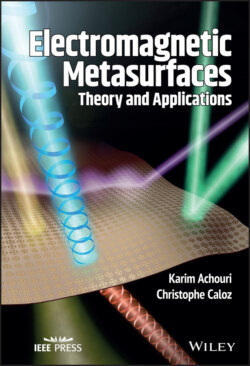Читать книгу Electromagnetic Metasurfaces - Christophe Caloz - Страница 17
2.3 Spatial Dispersion
ОглавлениеIn addition of being temporally dispersive, a medium may also be spatially dispersive. As temporal dispersion is a temporally nonlocal phenomenon, spatial dispersion is a spatially nonlocal phenomenon, whereby the response of the medium at the position depends on its excitation at position [9, 29, 52, 148]. This effect is important in metamaterials because it is fundamentally related to bianisotropy and artificial magnetism, as we shall now demonstrate.
Figure 2.3 Experimental dispersion curves of the permittivity of silver, gold, and aluminum [72, 102]. (a) Real part. (b) Imaginary part.
Note that an extensive treatment of the topic of spatial dispersion would be beyond the scope of this book. Here, we thus limit ourselves to a brief and simplified description of this phenomenon, while more advanced presentations may be found in [9, 29, 52, 148].
In order to show how spatial dispersion brings about bianisotropy and artificial magnetism in the constitutive relations, consider a medium with the conventional constitutive relations
(2.24a)
(2.24b)
where we have expressed the material polarization density, , in terms of the induced current density, (A/). Spatial dispersion is now introduced via the relationship between the induced current and the electric field [29],
(2.25)
where the dyadic tensor represents the response of the medium and is a volume of integration, centered at . We next restrict our attention to the case of weak spatial dispersion, where . We can then simplify (2.25) by using the three-dimensional Taylor expansion of truncated to the second order [29],
(2.26)
where the subscripts and run over , , and , which decomposes the second term in three terms and the third term in nine terms. Substituting (2.26) into (2.25) leads, after somewhat involved manipulations and simplifications [29], to
(2.27)
where the parameters are related to . Inserting then (2.27) into 2.24a yields
(2.28)
where is the Kronecker delta. The relation (2.28) corresponds to general second-order weak spatial dispersion constitutive relations. The presence of the spatial derivatives makes it practically cumbersome, and we shall therefore transform it into a simpler form [148]. For simplicity, we restrict our attention to the isotropic version of (2.28), which may be written as [29]
(2.29)
where is the permittivity, and , , and are complex scalar constants related to the parameters in (2.28). In order to simplify (2.29), we shall first demonstrate that Maxwell equations are invariant under the transformation [148]
(2.30a)
(2.30b)
where is an arbitrary vector. To prove this invariance, consider Maxwell–Ampère equation
(2.31)
Substituting (2.30) into this relation yields
(2.32)
which clearly reduces to
(2.33)
hence proving the equivalence of (2.33) and (2.31), and therefore demonstrating the invariance of Maxwell equations under the transformation (2.30) for any [148]. We now substitute (2.29) into (2.30) along with , which yields
(2.34a)
(2.34b)
Further substituting Maxwell–Faraday equation, , into (2.34) yields
(2.35a)
(2.35b)
Finally substituting these relations with into (2.30) leads to the relations
(2.36a)
(2.36b)
which take the compact form
(2.37a)
(2.37b)
where is a coupling parameter associated to chirality [26, 155] and where the parameter corresponds to artificial magnetism [122]. The constitutive relations (2.37) reveal, via (2.29), that chirality is related to spatial dispersion of the first order via in , while artificial magnetism is related to spatial dispersion of the second order via . Both chirality and artificial magnetism depend on the excitation frequency via . It may seem surprising that artificial magnetism is related to spatial dispersion but consider the following simple example, which is one of the easiest ways of creating an effective magnetic dipole. Consider, two small metal strips, one placed at a subwavelength distance to the other in the direction of wave propagation. If the conditions are met, a mode with an odd current distribution may be excited on the strips resulting in an effective magnetic dipole. In that case, the electric field on one of the strip slightly differs from the one on the other strip since they are separated by a distance , thus implying that the effective magnetic response of the strips spatially depends on the exciting electric field. If , then the difference of the electric field on the strips would vanish as would the effective magnetic dipole moment.
It is not possible to further transform (2.37a) to eliminate the double spatial derivative associated with . However, it turns out that is most often negligible compared to and , as discussed in [29, 148], so that this term may generally be ignored. Solving then (2.37) for ultimately leads to the spatial-dispersion relations
(2.38a)
(2.38b)
where , , and , which are the isotropic (or biisotropic) counterparts of the bianisotropic constitutive relations (2.4).
Note that when , then and . This means that the permittivity and permeability have fundamentally different dispersive nature, a fact that has important consequences for metamaterials, as we will see throughout the book.
